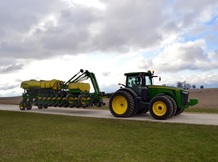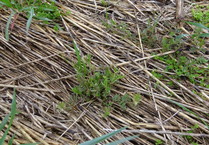Planting
season is here, let’s share the road and stay safe
Flowers are blooming, bees are buzzing and temperatures are
on the rise, which means that planting season is officially here. With more slow-moving
farm equipment on Indiana roadways, ISDA and several state agencies have
partnered together to encourage Hoosiers to be alert, slow down and share the
road.
Cultivating and planting 14.7 million acres of Indiana
farmland is no easy task. Farmers put in tiring and long hours
during planting season, and their safety, along with the safety of motorists,
is our top priority.
 According to the National Highway Traffic Safety
Administration, farm equipment vehicles (other than trucks) were involved in 92 fatal crashes across the nation, with six of those occurring in Indiana. Our hope this year is to reduce that number to zero.
Working towards this goal, below are seven safety tips to keep motorists and farmers safe this planting season:
|
- Most farmers will pull over when they are able to let you pass, but it may take time for them to get to a safe place to do so. Be patient.
- Farm equipment is wide, sometimes taking up most of the roadway. Be careful when passing.
- Do not pass if you are in a designated “No Passing Zone” or within 100 feet of any intersection, railroad grade crossing, bridge, elevation structure, or tunnel.
- Do not try to pass a slow-moving vehicle on the left without ensuring that the vehicle is not planning a left turn. It may appear that the driver is pulling over for you to pass when it is actually preparing to turn. You will drive right into its path, endangering yourself and the farmer.
- Avoid tailgating, as some farm equipment might have to make sudden stops along the road.
- Allow plenty of time to get to your destination, be aware of alternate routes and avoid distractions.
- Pay special attention to stationary farm equipment on the side of the road, as there might be farmers working nearby.
This important safety message cannot be shared or stressed enough this time of year, and by practicing these driving tips, we can ensure a safer planting season for farmers and motorists alike.
Along
with Lt. Governor Suzanne Crouch and ISDA, the following list
includes the agencies that participated this year: Indiana State
Police, Indiana Bureau of Motor Vehicles, Indiana Department of Homeland
Security and the Indiana Department of Transportation.
To learn
more or see quotes from our agency partners, click here.
Survey shows Indiana remains a top state for cover crops
Last week, people from all over the world celebrated Earth Day, which is a time for recognizing the importance of our natural resources, as well as the
individuals and organizations that conserve them.
For years, Indiana has been on the frontlines of the conservation
movement, and our farmers continue to set the bar nationally when it comes to
improving soil health and water quality.
According to a recent survey, Hoosier farmers planted 970,000 acres of
cover crops in 2017. This is more than five times the amount planted in 2011 and makes Indiana the leading state in the Midwest, if
not the nation. Based on this data, cover crops are now the third-most
planted crop in the state, next to corn and soybeans.
 However, it’s important to note that while farmers planted more acres in 2016, with the late harvest and heavy rains farmers experienced last year, not to
mention the tough farm economy, these results are particularly
commendable. It also
shows that farmers continue to find value and are experiencing the benefits of
planting cover crops.
According
to NRCS, cover cropping increases organic matter and soil biology, as well as improves
water infiltration and water-holding capacity. This practice also prevents
nutrients and sediment from running off the farm, keeping them out of nearby
waterbodies and streams.
As a result of the cover crops planted last fall, more than 2.9 million pounds of nitrogen, 1.4 million pounds of phosphorus and 1.2 million tons of sediment were prevented from entering Indiana’s waterways.
That’s enough sediment to fill 12,000 train cars which, if stacked end to end, would stretch 113 miles.
|
 In addition to cover crops, the survey also measures trends related to crop residue, which is the organic material left in the field after harvest. Crop residue further reduces sediment and nutrient runoff by protecting the soil from fall, winter and spring rain events. A no-till system leaves the most residue.
The survey shows that Indiana farmers left their crop residues undisturbed on:
- 67 percent of soybean acres
- 63 percent of corn acres
- 46 percent of small grain acres
- 20 percent of specialty crop acres
This reason this data is so important is because it allows us to
evaluate our efforts and better tell Indiana’s conservation story. In the
agriculture industry, no two years are alike, which is why it’s so important to
look at these trends over time and determine what adjustments need to be
made moving forward.
The cover crop transect survey is a collaborative effort between NRCS, ISDA, Indiana’s 92 Soil and Water Conservation Districts, Earth Team volunteers and other members of the Indiana Conservation Partnership, who team up to conduct a visual assessment of cropland county by county.
To learn more about the survey, click here, or to find transect data for your county, visit your local Soil and Water Conservation District office, which can be found by clicking here.
|
|